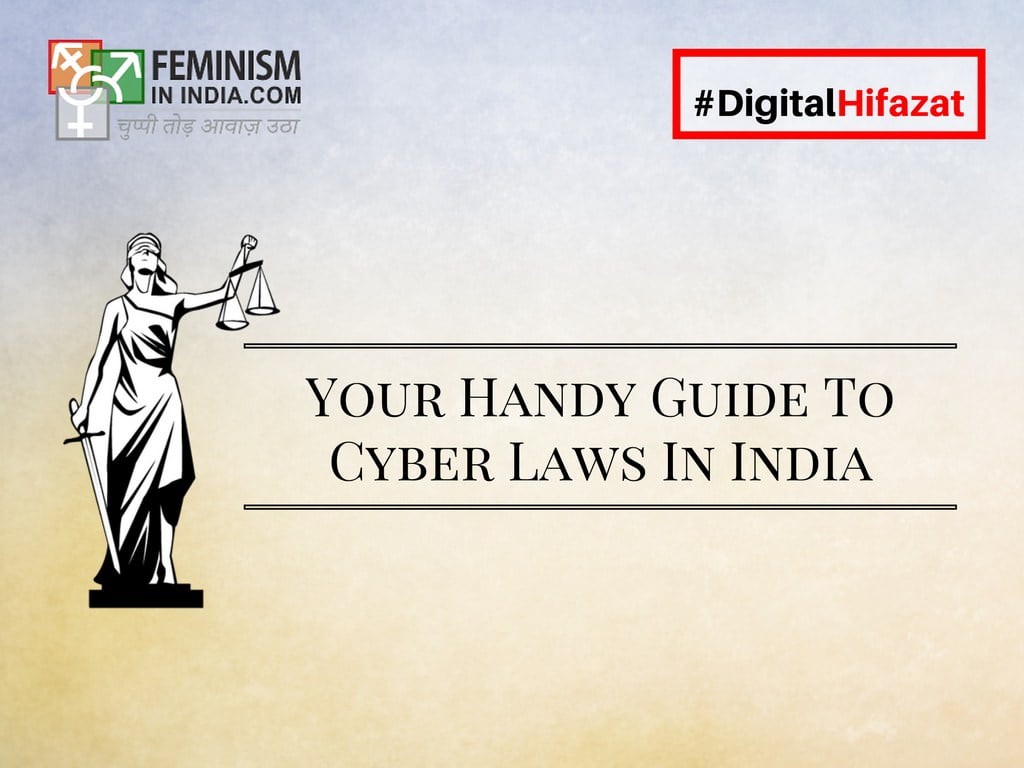The dependence on technology, particularly on platforms that facilitate social interaction, has seen an exponential rise what with the introduction of smart phones and tablets that help ensure we are constantly connected to the outside world. With access to the Internet and social media platforms becoming easily available across the country, there is an increasing need to address the security concerns that arises.
Only recently, Whatsapp Messnger, a cross-platform mobile messaging application that allows you to exchange messages over the Internet, was embroiled in a legal controversy over privacy concerns of users. But privacy of an individual is not the only concern in the cyber space. The virtual world is fraught with dangers and the security of an individual, particularly those of women, children and trans* people has become an acute issue with cyber crimes against them becoming an everyday. Cyber Crimes are crimes that happen over the web where the perpetrator of the crime, shielded by the veil of a computer screen need not establish physical contact with the victim or may not always revealed their identity.
Crimes over the internet could be in the nature of
- Cyber stalking
- Cyber bullying
- Cyber harassment
- Identity theft
- Breach and violation of privacy/confidentiality
- Voyeurism
- Revenge pornography, though falling within the ambit of cyber harassment, is one such cyber crime which has seen a lot of discussion of late owing to increased instances of non-consensual pornography
Recently, a US-based Indian woman took to Facebook, the social networking platform, to report an unknown person who claimed to have hacked into her account and was threatening to leak some private images and videos unless she sent him some nude images. A Twitter user redirected the post to the official account of Mumbai Police and they replied asking her to file a complaint. But that need not be the only way forward.
Legal Provisions Under Various Laws
Although a comprehensive regulatory framework with regard to laws governing the cyber space, particularly such acts is yet to be framed, there exists certain legal provisions under various Statutes which can come in aid of a person who is a victim of cyber violence.
The Indian Penal Code, 1860
Prior to 2013, no law directly dealing with online harassment or crimes pertaining to women in the cyber space. The 2013 Criminal Amendment Act to the Indian Penal Code, 1860 by way of Section 354A to Section 354D
- Section 354A: A man committing any of the following acts – a demand or request for sexual favours; or showing pornography against the will of a woman; or making sexually coloured remarks, shall be guilty of the offence of sexual harassment, may be punished with rigorous imprisonment for a term which may extend to three years, or with fine, or with both. In case of the first two and with imprisonment of either description for a term which may extend to one year, or with fine, or with both.
- Section 354C defines ‘Voyeurism’ as including the act of capturing the image of a woman engaging in a private act, and/or disseminating said image, without her consent. For the act to qualify as ‘Voyeurism’, the circumstances must be such where the woman would “usually have the expectation of not being observed either by the perpetrator or by any other person at the behest of the perpetrator”. A person convicted under this section is liable to be punished with fine as well as imprisonment up to three years on first conviction and seven years on subsequent convictions.
- Section 354D introduced a provision for stalking which also covers cyber stalking. Stalking has been defined to mean an act where a man follows or contacts a woman, despite clear indication of disinterest to such contact by the woman, or monitors the cyber activity or use of the Internet or electronic communication of a woman. A man committing the offence of stalking would be liable for imprisonment up to three years for the first offence, and shall also be liable to fine and for any subsequent conviction would be liable for imprisonment up to five years and with fine.
Other than the specific amendments that have been made to the Code, there exist certain other provisions under which cyber crimes may be reported or the accused may be charged. These are:-
- Section 499: To defame a person is to do an act with the intention of harming the reputation of the person. Defamation by publication of visible representations of an imputation concerning the woman, when done with the intention to harm her reputation, is punishable with imprisonment for a term, which may extend to two years, or with fine, or both.
- Section 503: Threats made to any person with injury to her reputation, either in order to cause alarm to her, or to make her change her course of action regarding anything she would otherwise do/not do is punishable as criminal intimidation. The act of blackmailing a person on the internet, as was done in the case mentioned above can be brought within the ambit of this provision.
- Section 507: This provision provides the quantum of punishment for Criminal Intimidation when the same is by a person whose identity is not known to the victim. Any anonymous communication, which amounts to criminal intimidation under Section 503 stated above, is punishable under this section.
- Section 509: Any person who utters any word or makes any sound or gesture, or exhibits any object with the intention that such word, sound or gesture or object be heard or seen by a woman and insult her modesty, or intrudes a privacy, may be charged under this section and imprisoned for a term that may extend to 3 years and also with fine. Instances of lewd comments or remarks made over the Internet, or other explicit images and content forcibly shared over the web may be penalized under this section.
The Information Technology Act, 2000 as amended by the Information Technology Act, 2008
- Section 66C of the IT Act makes identity theft a punishable offence. Instances of cyber hacking would be covered by this provision. Under this provision, whoever, fraudulently or dishonestly make use of the electronic signature, password or any other unique identification feature of any other person, shall be punished with imprisonment of either description for a term which may extend to three years and shall also be liable to fine which may extend to rupees one lakh.
- Section 66E of the IT Act deals with the violation of the privacy of a person. Capturing, publishing or transmitting the image of a private area of any person without her consent, under circumstances violating her privacy, is punishable with imprisonment, which may extend to three years, and/or fine.
- Section 67 prohibits, and punishes with imprisonment extending up to three years and fine for first conviction and to five years and fine upon second conviction, the publication, transmission and causing of transmission of obscene content. Obscene content has been defined in the same manner as in Section 292 of IPC, and therefore the test of obscenity is to be the same as under that provision
- Section 67A makes the publication, transmission or causing of transmission of sexually explicit material punishable with imprisonment extending up to five years and fine for first conviction and to seven years and fine upon second conviction.
- Section 67B makes publication/transmission of sexually explicit content depicting children punishable.
The Protection of Children from Sexual Offences Act, 2012 (POCSO)
POCSO is a key legislation governing sexual harassment of children and their protection thereof. Under the provisions of the Act, sexual assault, harassment and pornography where the victim of the same are children are made punishable offences as is the abetment of any of the offences mentioned under the Act.
a. Under Section 11 of the POCSO Act, a person is said to commit sexual harassment upon a child when such person:
(i) utters any word or makes any sound, or makes any gesture or exhibits any object or part of body with the intention that such word or sound shall be heard, or such gesture or object or part of body shall be seen by the child and does so with sexual intent or
(ii) makes a child exhibit his body or any part of his body so as it is seen by such person or any other person; or
(iii) shows any object to a child in any form or media for pornographic purposes; or
(iv) repeatedly or constantly follows or watches or contacts a child either directly or through electronic, digital or any other means; or
(v) threatens to use, in any form of media, a real or fabricated depiction through electronic, film or digital or any other mode, of any part of the body of the child or the involvement of the child in a sexual act; or
(vi) entices a child for pornographic purposes or gives gratification.
‘Sexual intent’ in such circumstances, is to be determined on the facts of the case
b. Section 12 further provides for punishment for the said offences and the acts are punishable for imprisonment for a term which may extend to three years with a fine.
c. Section 13: The use of a child or the involvement of a child through any medium like print, electronic, computer or any other technology for preparation, production, offering, transmitting, publishing, facilitation and distribution of the pornographic material, irrespective of it being for personal use or distribution, when done with the purpose of sexual gratification amounts to use of the Child for pornographic purposes under Section 13 of the Act. Sexual gratification under this provision includes:
(i) representation of the sexual organs of a child;
(ii) usage of a child engaged in real or simulated sexual acts (with or without penetration);
(iii) the indecent or obscene representation of a child, shall be guilty of the offence of using a child for pornographic purposes.
d. Under Section 15, the storage of pornographic material involving child for commercial purposes in any form is also punishable with imprisonment which may extend to three years or with fine or with both.
e. Under Section 20, The POCSO Act further imposes an obligation on personnel of the media or hotel or lodge or hospital or club or studio or photographic facilities, irrespective of the number of persons employed to provide to the Special Juvenile Police Unit, or to the local police on coming across any material or object which is sexually exploitative of the child including pornographic, sexually-related or making obscene representation of a child or children) through the use of any medium.
f. Under Section 19, the Act also enumerates the procedure for reporting cases of child sexual harassment to the Special Juvenile Police Unit or the local police and states that the complaint is to be recorded in simple language so as to enable the child to understand the contents of the complain.
Other than the provisions of law mentioned above, there are certain proposed amendments to existing laws that aim to secure the web as far as women are concerned. One such key amendment is the
Indecent Representation Of Women (Prohibition) Bill, 2012
- The Indecent Representation of Women (Prohibition) Act regulates and prohibits the indecent representation of women through the media of advertisements, publications etc. The Indecent Representation of Women (Prohibition) Amendment Bill, 2012 seeks to broaden the scope of the law to cover the audio-visual media and content in electronic form, and distribution of material will also include distribution on the Internet and the portrayal of women over the web.
About the author(s)
Graduate from Lady Sri Ram College & Faculty of Law, University of Delhi. Currently working as a Law Researcher at the High Court Of Delhi.




